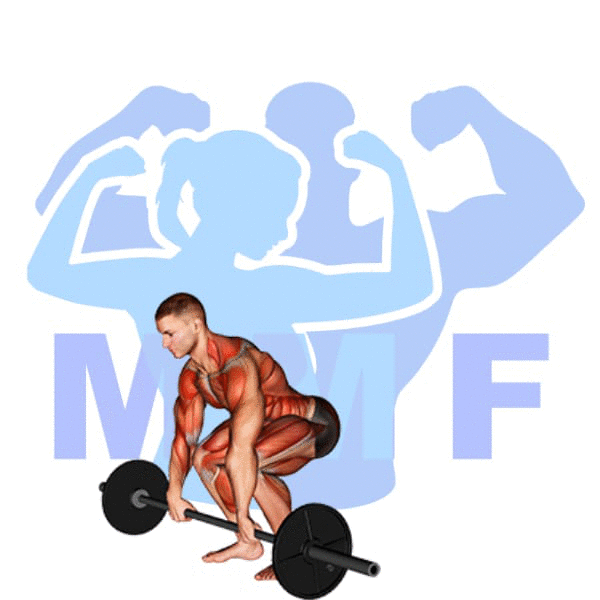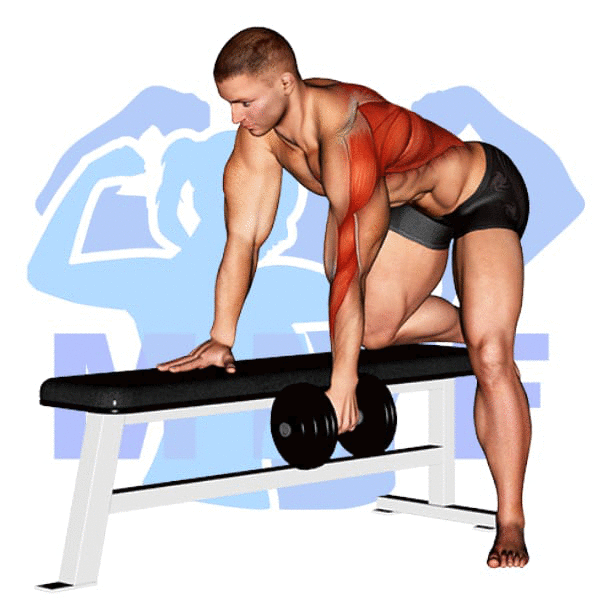Are you struggling to build upper body strength and definition? Do you find yourself stuck in a plateau, unable to make progress in your lifting routine? Fear not, for you are not alone. One common mistake that many weightlifters make is neglecting the importance of variety in their training. They become comfortable with their usual exercises and fail to challenge their muscles in new ways. Fortunately, this problem has a simple solution: the alternating dumbbell raise. In this post, we will discuss the benefits of this exercise and how to properly incorporate it into your routine for maximum results.
Alternating Dumbbell Raise Summary
- Primary Muscles: Deltoid – Lateral
- Secondary Muscles: Deltoid – Anterior, Serratus Anterior, Supraspinatus, Trapezius – Lower, and Trapezius – Middle
- Equipment: Dumbbells
- Mechanics Type: Isolation
- Force: Push
- Utility: Auxiliary

Alternating Dumbbell Raise Instructions
- Start by taking up the dumbbells and resting them on top of your thigh while standing straight up.
- Now while keeping your arm straight rain the dumbbell up infant of you until your arm is parallel with the ground.
- Pause and in the up position for a moment so that you are not swinging your arms.
- Now you can lower one dumbbell as you raise the other, or you can lower one pause and raise the other.
- If you pause you are less likely to use momentum and more likely to isolate your deltoid.
- Continue until you have carried out a whole set.
Video Tutorial
Alternating Dumbbell Raise Muscles
Target (Agonist)
Synergists
Dynamic Stabilizers
- None
Stabilizers
- Levator Scapulae
- Trapezius – Upper
- Wrist Extensors
Antagonist Stabilizers
- None

Benefits of Alternating Dumbbell Raise
The Alternating Dumbbell Raise is an effective exercise for targeting the lateral deltoid muscle. This exercise works the lateral deltoid by isolating it and forcing it to work independently from other muscles. Additionally, the alternating motion of the dumbbells helps to create a more balanced development of the lateral deltoid and adds stability to the shoulder joint. By performing this exercise regularly, you can help improve your shoulder strength and range of motion, as well as overall shoulder stability and posture.
Tips for Performing Alternating Dumbbell Raise
If you want to experience the greatest benefits, you should always focus on these simple and easy tips. Also, whenever you desire to avert your chance of an injury, you ought to adhere to these tips.
- Watch Your Technique by Make Use Of A Mirror. You could think you are a little vain looking in a mirror when you are training, but you are not checking yourself out, you are making certain your form is effective.
- Perform A Adequate Warm-Up Prior To You Begin Adding Your Heavy Weight. Not doing a proper warmup is the most prevalent way to injure yourself.
- Always Keep A Training Journal. You need to have a log of all weights, sets and repetitions. If you are great you may also note your rest intervals. Now there are plenty of high-quality apps to use a journal, or you may simply try a little note pad.
- Stay Hydrated. You’ll have considerably more energy and recover faster when you drink water while exercising.
Benefits and Tips Video
Frequent Mistakes To Avoid
You will need to refrain from these regular issues to build and maintain solid technique and see large gains. Moreover, when you avoid these mistakes you will decrease the odds of having an injury.
- You Must Not Try To Use More Weight Than You Can Do Safely. You’re going to forfeit your technique and could very well end in a physical injury any time you make an attempt to work with more than you should.
- You’ll Do Better To Not Conduct The Same Lifts Each And Every Moment. Any time you execute the same exercise every workout ones muscles is likely to be conditioned to perform that sole exercise good, but you will plateau sooner.
- Stop Trying To Skip Out On Your Cooldown. You can minimize your healing period and lower soreness when you accomplish a good cool down.
Find More Dumbbell Exercises Here
Variations and Complementary Exercises
If you are looking for additional ways to target the same muscle groups as the Alternating Dumbbell Raise, there are a variety of exercises that can serve as alternative, complementary, or variations. Below is a list of some of these exercises.
Alternating Dumbbell Vertical Front Raise

The Alternating Dumbbell Vertical Front Raise is a great alternative or complementary exercise to the Alternating Dumbbell Raise. It is performed in the same standing position, but with the arms raised in front of the body instead of out to the sides. This exercise targets the anterior deltoids, upper trapezius, and serratus anterior. It also engages the core muscles to stabilize the torso as it supports the weight of the dumbbells. This exercise can be used for both strength and muscle building, and it can be adapted to fit any fitness level by adjusting the weight of the dumbbells.
Band Front Raise

The Band Front Raise is a great alternative or complementary exercise for the Alternating Dumbbell Raise. This exercise targets the front deltoid muscles and is performed by standing with feet shoulder-width apart and holding a resistance band in both hands. The arms are kept straight in front of the body and the band is pulled up and out to shoulder height. The arms are then lowered back to the starting position. This exercise is great for developing shoulder strength and stability, making it an ideal addition to any shoulder workout.
Band Upright Row

The Band Upright Row is an excellent alternative or complementary exercise to the Alternating Dumbbell Raise. It works your shoulders, arms, and upper back muscles while also providing a great cardiovascular challenge. The exercise is performed by holding a band in each hand, with elbows bent and palms facing up. Then, you pull the bands up to your chest while keeping your elbows close to your body. This exercise will help you build strength and stability in your shoulders and upper back, while also giving you a great cardio workout.
Check Out These Top Dumbbell Exercises
Barbell Front Raise

The Barbell Front Raise is an excellent complementary or alternative exercise to the Alternating Dumbbell Raise. It works the same muscles, but in a slightly different way. It requires you to keep your arms straight while lifting the barbell up in front of your body. This exercise focuses on the deltoids and the front of the shoulder, while also engaging the arms and upper back. It is a great choice for those looking to build size and strength in their shoulders.
Barbell Standing Front Raise Over Head

The Barbell Standing Front Raise Over Head is an excellent complementary or alternative exercise to the Alternating Dumbbell Raise. It works the same muscles in the shoulders and upper arms, but it also engages the core and lower back muscles as you work to keep your torso stable. This exercise can be performed with heavy weight and allows you to lift a greater amount of weight than the Alternating Dumbbell Raise. Additionally, it provides an increased range of motion compared to the Alternating Dumbbell Raise, allowing you to fully stretch and engage the muscle fibers in your shoulder and upper arm.
Barbell Standing Upright Row

The Barbell Standing Upright Row is an excellent complementary or alternative exercise for the Alternating Dumbbell Raise. This exercise targets the same muscles as the Alternating Dumbbell Raise, with the added benefit of allowing you to lift heavier weights. To perform this exercise, hold a barbell at hip-level with an overhand grip and pull it up to your chest while keeping your elbows close to your body. As you lift the barbell, focus on keeping your core tight and squeezing your shoulder blades together. The Barbell Standing Upright Row is a great way to build upper body strength and is especially effective when combined with other exercises such as the Alternating Dumbbell Raise.
Find More Shoulders Exercises Here
Opposing Complementary Exercises
To complement the Alternating Dumbbell Raise, you can try some of these exercises that work the opposing muscle groups. These exercises will help you to achieve balance and optimal strength in the muscles around your shoulder blades.
Wide Grip Chest Dip

Wide Grip Chest Dip is a great complementary exercise to Alternating Dumbbell Raise as it focuses on the opposing muscle group. This exercise works the triceps and chest muscles, while the Alternating Dumbbell Raise emphasizes the deltoids. This combination of exercises allows for a more complete workout and helps to prevent overuse injuries by targeting different muscle groups. By performing both exercises, you will be able to build strength and endurance in your chest and shoulder muscles.
Chest Dip

The chest dip is a great complementary exercise to the alternating dumbbell raise, as it works the opposing muscle group. The chest dip works the lower chest and front deltoids, while the alternating dumbbell raise targets the upper chest and rear deltoids. This makes the two exercises a great combination for working both the upper and lower chest, as well as the front and rear deltoids. Chest dips can be done with either a dip bar or using two chairs, making them easily accessible to those who don’t have a gym membership.
Weighted Tricep Dips

Weighted Tricep Dips are a great complementary exercise to the Alternating Dumbbell Raise. This exercise targets the triceps, which are the opposing muscle group to the biceps used in the Dumbbell Raise. By performing Weighted Tricep Dips, you can strengthen the triceps, allowing for a balanced development of both muscle groups. Additionally, Weighted Tricep Dips increase your upper body strength and can help improve your overall athletic performance.
Lift Your Way to a Stronger Upper Body with Alternating Dumbbell Raise!
If you are looking to strengthen your upper body, the alternating dumbbell raise is a great exercise to include in your routine. This exercise targets your shoulders and upper back muscles, helping to improve posture and build strength. By using dumbbells, you can adjust the weight to your fitness level and challenge yourself as you progress. Whether you are a beginner or an experienced lifter, the alternating dumbbell raise is a versatile exercise that can benefit anyone looking to develop a stronger upper body.
References: Wikipedia | ExRx.net | PubMed.gov | Comprehensive List of Shoulders Dumbbell Exercises




